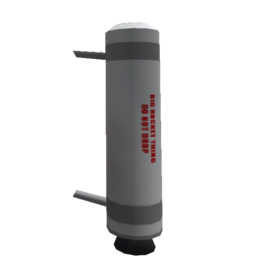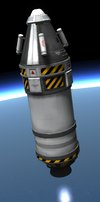Difference between revisions of "Sepratron I"
From Kerbal Space Program Wiki
Zombie Elvis (talk | contribs) (→Usage: clarified the decoupling list item) |
m (Added to list of uses) |
||
| Line 17: | Line 17: | ||
* Debris clean up: Sepratrons can be used to deorbit small, unused probes or parts on a low orbit. | * Debris clean up: Sepratrons can be used to deorbit small, unused probes or parts on a low orbit. | ||
* Weapons: Sepratrons can be for making missiles. | * Weapons: Sepratrons can be for making missiles. | ||
| + | *Safer Landing: The Sepratron can be used to slow a craft before using a parachute. | ||
== Product description == | == Product description == | ||
Revision as of 18:22, 15 April 2016
| Sepratron I | ||
| Solid rocket booster by Periapsis Rocket Supplies Co | ||
| Radial size | Radial mounted | |
| Cost | (total) | 75.00 |
| (dry) | 70.20 | |
| Mass | (total) | 0.073 t |
| (dry) | 0.013 t | |
| Drag | 0.2-0.3 | |
| Max. Temp. | 2000 K | |
| Impact Tolerance | 7 m/s | |
| Research | | |
| Unlock cost | 1 100 | |
| Since version | 0.17 | |
| Part configuration | solidBoosterSep.cfg | |
| Maximum thrust | (1 atm) | 13.79 kN |
| (vacuum) | 18.00 kN | |
| Isp | (1 atm) | 118 s |
| (vacuum) | 154 s | |
| Fuel consumption | 1.59 | |
| Thrust vectoring | No | |
| Burn time | (1 atm) | 3.9 s |
| (vacuum) | 5 s | |
| Testing Environments | ||
| On the surface | No | |
| In the ocean | No | |
| On the launchpad | Yes | |
| In the atmosphere | Yes | |
| Sub-orbital | Yes | |
| In an orbit | Yes | |
| On an escape | No | |
| Docked | No | |
| Test by staging | Yes | |
| Manually testable | Yes | |
| Packed volume | 25 l | |
| Stacking capacity | 2 units | |
| Solid fuel | 8 | |
The Sepratron I is a very tiny solid rocket booster with a very short burn-duration but a great amount of thrust for its mass.
Usage
Unlike traditional SRBs, the Sepratron provides too little thrust to be useful during most takeoffs. Instead it offers two great advantages over other boosters: Its small size allows the Sepratron to be placed on almost any surface, while its low weight generally eliminates the need to detach them after burn-out. Red block letters on its casing read "BIG ROCKET THING. DO NOT DROP".
Possible uses include:
- Rocket-assisted take-offs: by mounting Sepratrons on the body of a plane, they can be used for shorter takeoffs.
- Stage detachment: When placed on a spent stage, angled correctly and placed in the same stage order as the detachment of that spent stage, the Sepratrons will drive those spent stages away from the remaining craft without hitting it. This is useful for larger boosters attached via radial decouplers whose own ejections don't drive the parts far enough away from the remaining craft to prevent damage to it.
- Test launches of lightweight vehicles: Sepratrons can used to simulate conditions for small craft, such as lifting a rover off the surface to determine if it can survive a landing. Note that Sepratrons can quickly overheat adjacent parts.
- Emergency escape engines: attached to a capsule or other important part and bound to the "Abort" action group, Sepratrons allow said parts to quickly and easily escape from exploding rockets and other emergencies. Now with the Launch Escape System, larger manned spacecraft (such as those which use the small to large radial sized Mk1-2 Command Pod) can use it instead, but Sepratrons are still the better solution for smaller manned spacecraft such as the one pictured.
- Preventing thrust loss: Activating Sepratrons while decoupling a stage can be used to maintain constant thrust.
- Debris clean up: Sepratrons can be used to deorbit small, unused probes or parts on a low orbit.
- Weapons: Sepratrons can be for making missiles.
- Safer Landing: The Sepratron can be used to slow a craft before using a parachute.
Product description
| “ | A small canister filled with what appears to be solid rocket fuel. Although not much of a step forward in terms of raw power, Kerbal Scientists have slowly warmed up to the Sepratron I's many uses, such as pushing things away. For best results, angle before use. | ” |
Changes
- Mass decreased from 0.2175t Full, 0.15t Empty to 0.0725t Full, 0.0125t Empty. Thrust decreased from 20 kN to 18 kN. Fuel capacity reduced from 9L to 8L. The Sepratron I now has the best TWR of all stock engines.
- Initial release.

